Cactus rot is a very common problem, and one of the main causes of their death. It can start anywhere on the plant – from the bottom, the top, or somewhere in between.
But just because your cactus is rotting doesn’t mean you can’t save it. No matter where it starts, there are steps you can take to remove it and stop it from spreading.
In this post, I’ll talk about the causes and symptoms, answer all of your questions, and give you step-by-step instructions for how to save your cactus from dying.
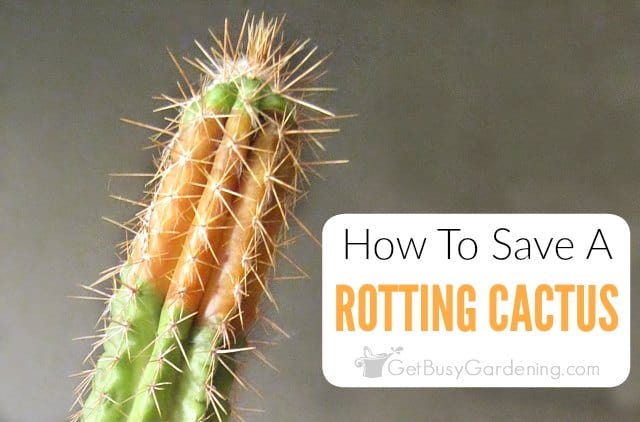
Why Is My Cactus Turning Brown?
When a cactus turns brown and gets soft, mushy, or squishy, it’s likely caused by rot. It’s not always brown, it can also appear black or yellow in color.
Unfortunately, once it starts, it won’t stop. Without intervention, it will continue to spread all the way through the entire stem, eventually killing the plant.
Related Post: How To Care For Cactus Plants
Why Is My Cactus Rotting?
The main cause is usually excess moisture, which can either be from overwatering or from water pooling and sitting on top of the plant. But sometimes it could be caused by a fungus or disease.
- Cactus bottom rot is usually caused by overwatering. An overwatered cactus doesn’t always start rotting right away, and it can begin below the soil surface. So it might not be obvious that was the cause.
- Cactus tip or stem rot is common on damaged plants. It is usually caused by a fungus or a disease infecting the wound, or from watering getting into it, causing the plant to rot from the inside out.
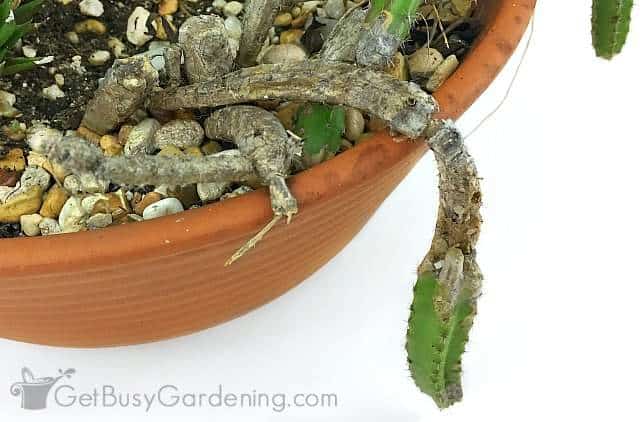
How To Save A Rotting Cactus
Once you notice rot you’ll need to act fast, because it will spread quickly and eventually kill your cactus. The steps for saving your plant depend on where it started.
So first I will show you the steps for how to save a cactus that is rotting top down. Then, in the section below that, I’ll talk about saving one that’s rotting from the bottom up.
Related Post: How To Water A CactusPlant
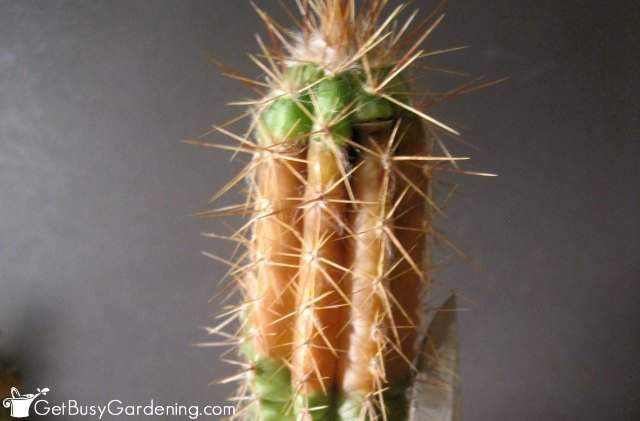
How To Save A Cactus Rotting Top Down
Cactus tip or stem rot can be very deceiving. You may notice small brown spots and think that there’s just a tiny bit.
Then, once you start removing the bad spots, many times you’ll realize that it’s much, much worse on the inside than it looked on the outside.
So first, take a moment to prepare yourself for what you may find once you start cutting. Ready? Ok, let’s do this one step at a time…
Step 1: Choose the right tool – You can use either a sharp knife or a pair of pruning shears to remove the rot. If your cactus is really thick, then I recommend using a sharp knife.
For small plants with thin stems, precision pruners or bonsai shears would work great. Just make sure they’re super sharp so they don’t crush the stem.
Step 2: Clean the blades (do NOT skip this step!) – Whatever tool you choose to use, it’s extremely important that you clean and sterilize it before making any cuts. This will help prevent infection or the spread of disease and fungus spores.
You can simply wash the blades with soap and warm water, or sterilize them with rubbing alcohol, and then dry them before you start. I also recommend that you clean them again between each cut.
Step 3: Remove the rot in layers – It’s best to cut the rot off in layers so you’re sure that you got it all, without removing too much of the healthy tissue in the process.
In the photo below, you can see that the center of the healthy-looking portion of my cactus still has rot on the inside. So we have to keep going…
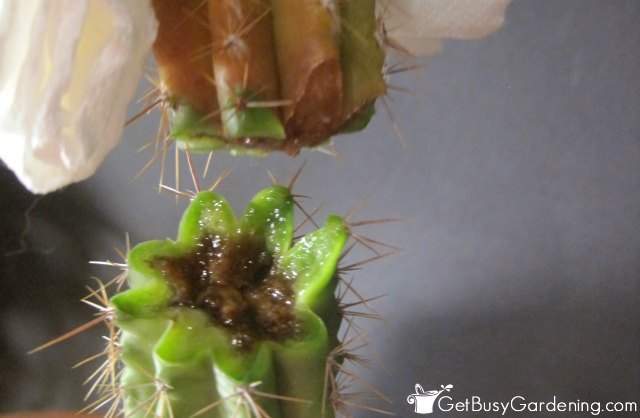
Step 4: Continue removing layers – As you work your way down, slowly cutting off small sections of the stem, the rot will get noticeably thinner and thinner.
But remember, even a tiny bit of it will likely continue to spread. So, be sure you remove all of the brown, soft, and mushy cactus material until no more signs of rot remain.
If yours is outdoors, make the last cut at a downward angle so water won’t settle into the wound (which will likely cause it to rot again). I would also move it to a dry area where it’s protected from rain until the wound has callused over, if possible.
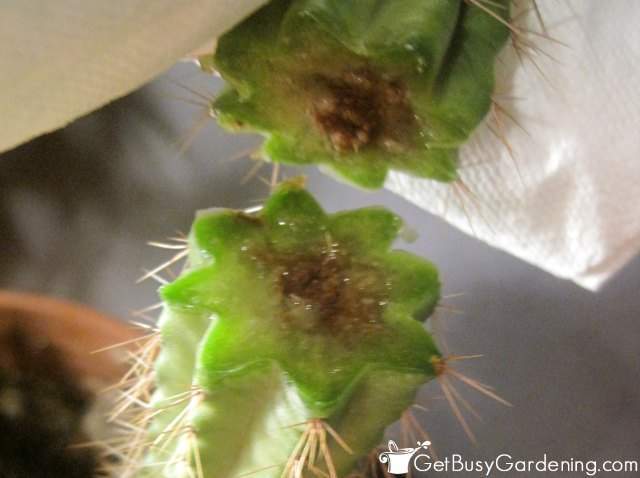
Unfortunately, the rot on this cactus was really severe before I noticed that the top was turning brown. So I had to cut off over half of the stem to get rid of all of it.
As difficult as it was for me to remove such a large section, I know my plant would have been dead in a matter of weeks if I hadn’t done anything to save it.
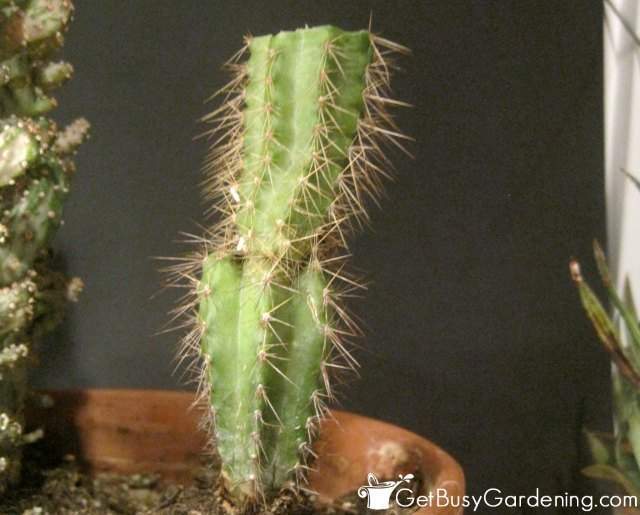
Monitor Your Plant Afterward
If you have to perform this type of surgery on one of your beloved cacti, keep an eye on it afterward to make sure it doesn’t continue to rot. If it starts again, follow the same steps above to remove the new rotting section.
After a couple of days, the wound should callus over, and your plant will eventually send out new growth near the cut.
I was very sad that I had to basically cut my cactus in half to remove all of the rot. But heck, in the end I think it added more character to the plant, don’t you?
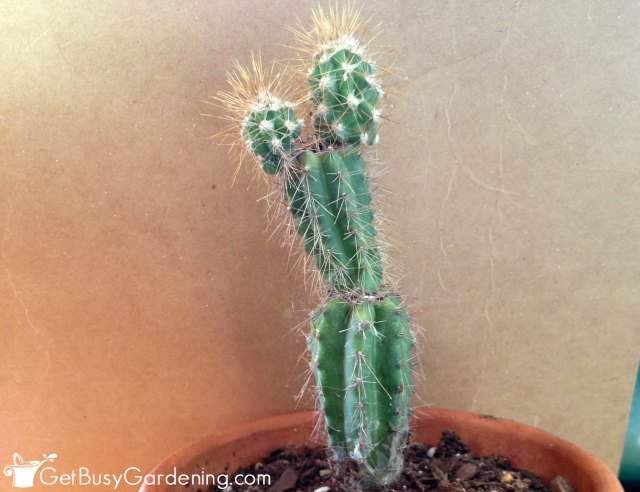
How To Save A Cactus Rotting Bottom Up
Unfortunately, if the bottom of the stem or the roots are rotten, then the only way to save your cactus is to try propagating a healthy cutting.
Take your cutting just above the rotting section. Then follow the steps above to remove additional layers as necessary to get rid of all of it.
Allow the cutting to dry for several days until the end has callused over. Then dip it in rooting hormone and stick it into a sandy soil mix.
Don’t water it until you see new growth on the cutting. Depending on the variety you have, it can take several weeks for roots to develop.
Related Post: How To Make Your Own Cactus Soil Mix (With Recipe)
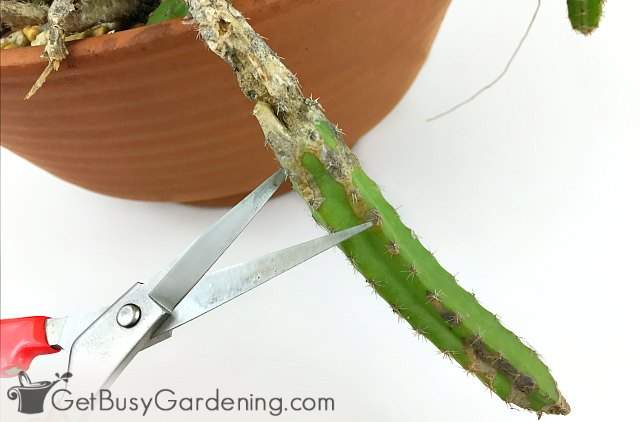
If you want to learn all there is to know about maintaining healthy indoor plants, then you need my Houseplant Care eBook. It will show you everything you need to know about how to keep every plant in your home thriving. Download your copy now!
More Houseplant Care Posts
- How To Grow Indoor Plants: The Ultimate Guide
- Houseplants Don’t Like Drafts
- How To Rebloom Your Amaryllis Plants
- How To Fertilize Houseplants
- Why Do Spider Plant Tips Turn Brown & How To Fix It
- Why Do Cyclamen Leaves Turn Yellow & How To Fix It
Share your tips for saving a rotting cactus in the comments section below.
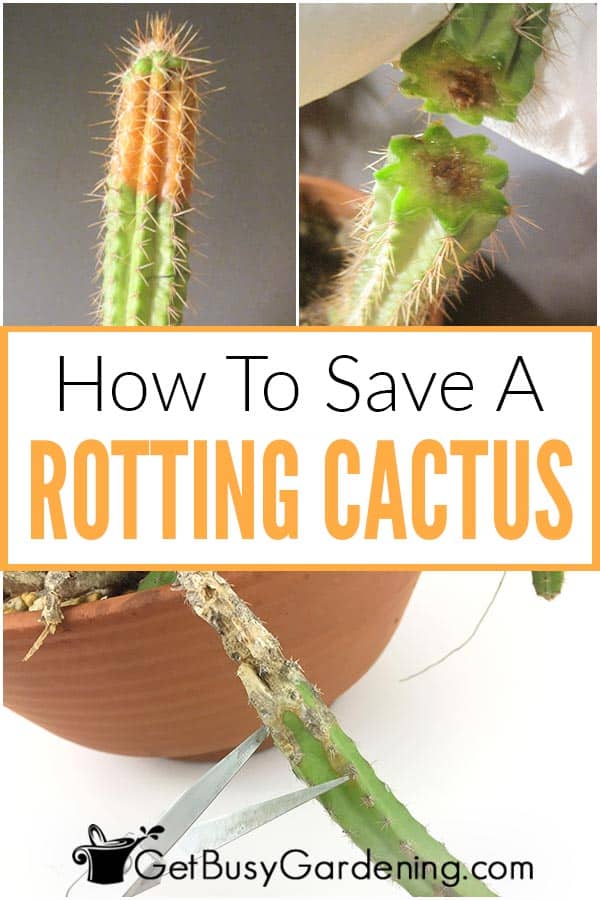
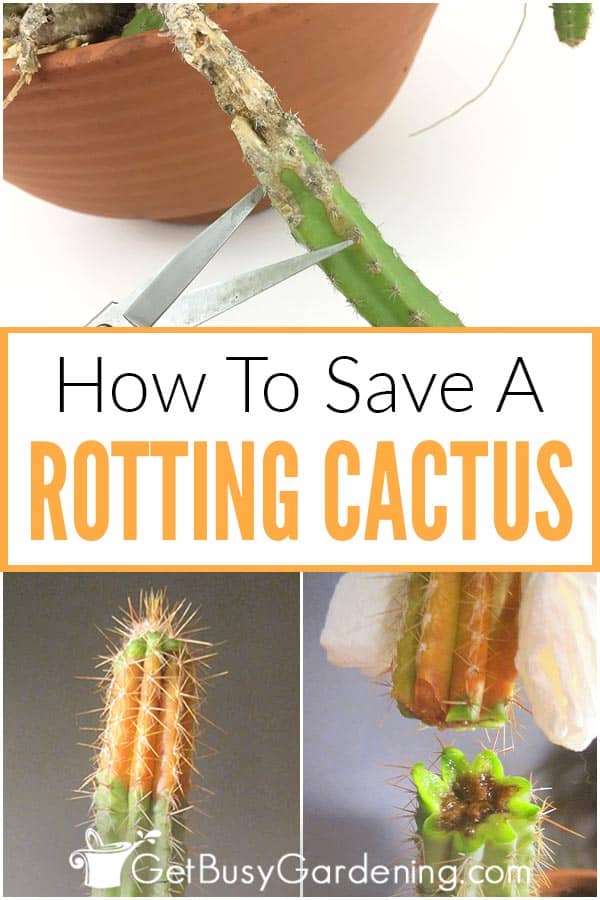
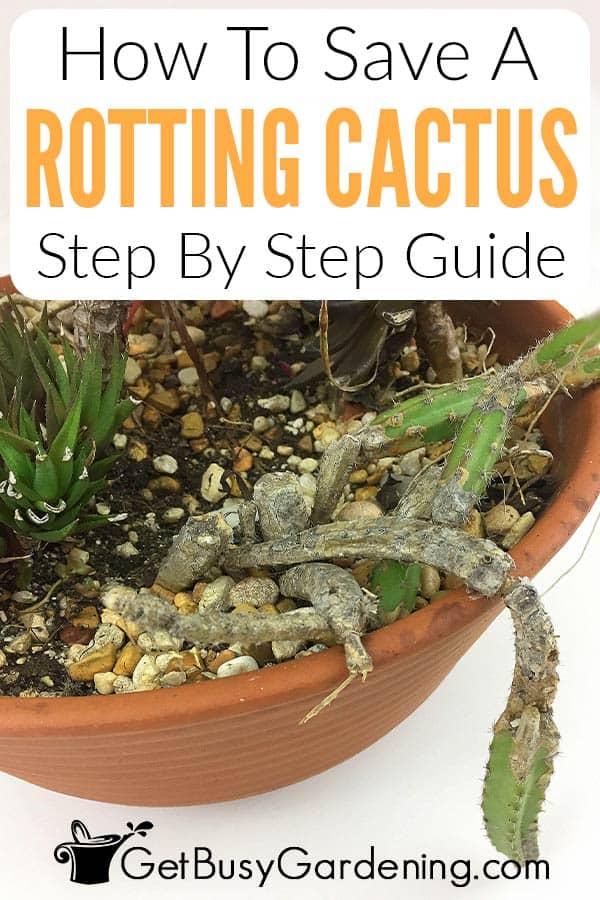
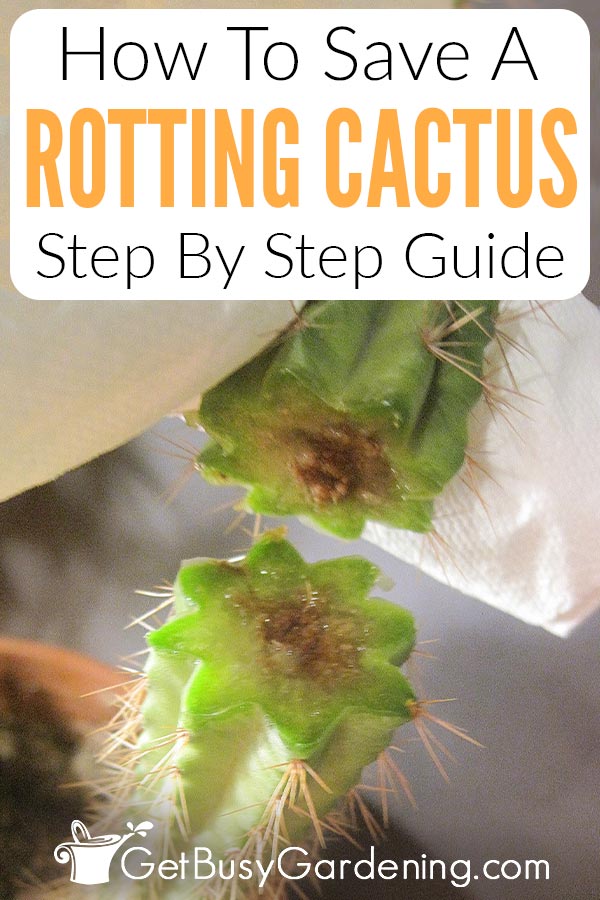
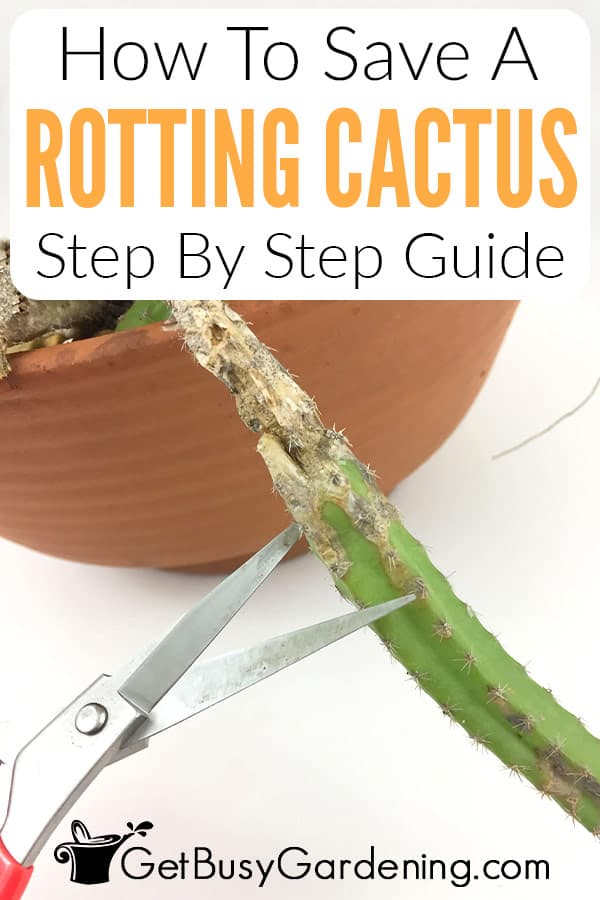
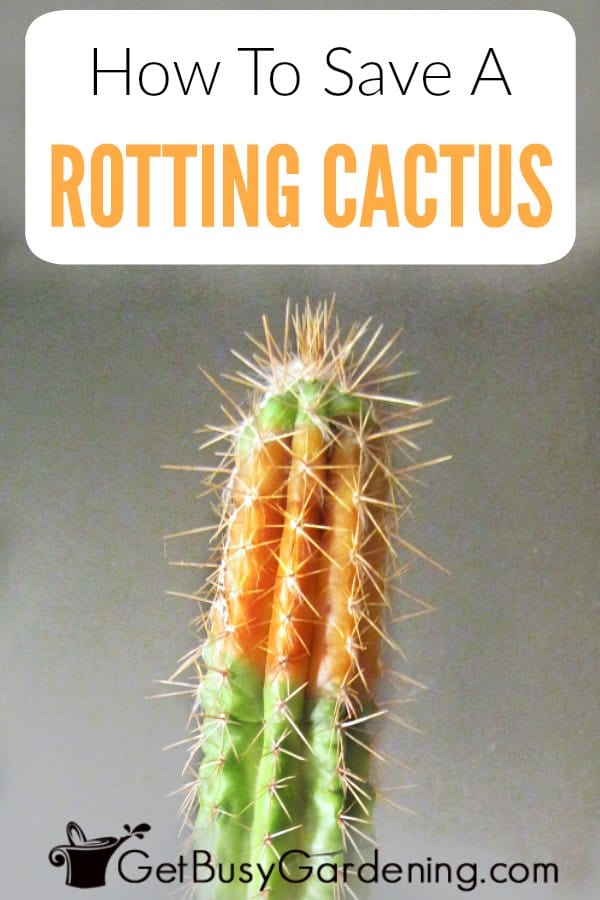



Jeffrey says
I have a Peruvian Cactus, 60 years old. 12 years ago started having a problem with tops of stems turning black, then shriveling up, and staying like that. Maybe 6″-8″ of shriveling. The blackening and drying out never goes down the whole stem. I cut off the blackened, shriveled top, (flesh looks fine below the blackened) it heals up, and couple of years later the same stem may do the same thing, from the top down. Or different stem(s). Cactus lives indoors. Tried watering 1x mo, or every several months.
At the same time, new growth starts. I’ve had it out of pot several times hoping to identify a root problem, but to my uneducated eye the roots look fine, firm, sending out more roots.
I have found no examples on-line of this particular problem. At this point only a 1/3 of plant is left. Happy to send pics.
Amy Andrychowicz says
I would first check the location where you have it. If you live in a very humid climate, or your cactus is sitting someplace where water drips on it (like under the eves of your house, for example), then that is likely causing the recurring rotting. Definitely slow down on watering. The soil should be dry before you water again – and once a month might be too much (depending on how large the plant and pot are). Also, when you cut off the rotting top pieces, make the cuts at a downward angle if you can. Otherwise, if it’s a flat cut, water can pool in the callus and cause more rotting later on. Here are my tips for how and when to water a cactus plant. Good luck!
jeffrey says
thanks for the comment. The cactus is located indoors, so no rain, no dripping. i’ve tested the moisture content before watering, always dry, says the moisture meter. Since my original post the cactus has been moved into a much small pot, since the larger one was making it too heavy to move easily. And, there is less cactus than there was a year or two ago.
I haven’t thought of the problem as ‘rot’. the blackened areas are not soft. Mostly (though not always) the issue is at top of stem, and self limits. Eventually shrivels up.
Amy Andrychowicz says
Have you checked it for bugs. It sounds like it could be spider mites, but here’s a list of the most common houseplant pests to check for.
jeffrey says
I read your article about the various possible bugs. I am not seeing evidence of any of the them. No evidence of any bugs on the cactus, that I can tell..
Again, I am happy to send a pic if you like. It doesn’t look like any pic I have seen of various cactus diseases.
Amy Andrychowicz says
Yes, you can go ahead and upload your photo to my Facebook page and I will be happy to take a look to see if I can figure out what’s wrong with your ailing cactus plant.
jeffrey says
i am happy to upload photo, but i don’t see where on your fb page to do that. help?
Amy Andrychowicz says
You should be able to click on “Message” near the top of the page and send it to me that way.
Victoria says
I’m not entirely sure what type of cactus I have but it’s rotting from the bottom but putting out new growth at the top. Is there any way I can save it?
Amy Andrychowicz says
It completely depends on the type of cactus you have. If it has new growth on top of the rotting base, then you may be able to take cuttings and root them. See the instructions under the section “how to save a catus rotting from bottom up” in the article for tips on how to do that.
Cheryl Loar says
My 30 yr.-old barrel cacti succumbed to the massive CA rainstorms. They look like fallen souffles, but the trunks are in place. Will they regrow or should the entire plant be removed? Three of five have fallen.
Thanks,
Cheryl Loar
Amy Andrychowicz says
Oh no, I’m so sorry to hear your barrel cacti have rotted from all the rain. Such a bummer!! If the base is still green and firm, then you certainly could try cutting off all of the rotted portions and see if they will regrow. The main plant won’t grow back, but you may get some new babies off of them.
Lex says
I just bought a cactus the other day—I’m planning to repot him but I was worried about his roots (they seem weirdly dry/flakey—one especially so). The little flower on him, which has not bloomed yet, is starting to droop, so I’m trying to figure out what I’m doing wrong. How do you identify root rot?
Amy Andrychowicz says
It sounds to me like your cactus plant is ready for some water. If the soil is bone-dry, then give it a drink. If it is wet or damp at all, then wait for it to dry completely before giving it more. If it were root rot, the roots would be brown and mushy, not thin and dried out.
Vera Michael says
My night blooming cactus has the leaves at the tips dying..is this a fungus or from overwatering. I have had it about 4 or 5 years. I keep cutting the bad parts off .. it’s rapidly getting worse.can I save it?
Amy Andrychowicz says
Though it could certainly be some kind of fungus, the most common cause of rotting cactus leaves is overwatering or too much humidity. Make sure the soil dries out completely between waterings and ensure that water is never dripping or sitting on the leaves. Also, disinfect your pruners between cuts to prevent the spread of potential disease or fungus.
Natalie says
Hi Amy,
I have the same problem with two types of cacti. My 14 y/o candelabra tree’s top was broken (it’s in a huge pot) when we moved. Now the top is dry brown. According to your advice I should cut it neat, wash it (just water and soap or something else like peroxide?) and try to reattach the part that fell? You didn’t explain how to reattach the 2 parts though. I’m confused and scared it will rot again.
I also have a few priclypears in pots. They were outgrowing their pots so I trimmed them where the leaves form. Now some of my leaves are rotten, hard brown, sometimes only yellow. I need to sell my cacti but I’d like to fix them before, it doesn’t look good. If I cut the bad leaves how can I be sure that the leaves I cut from won’t rot. How can I protect them? Does cleaning them will be enough or should I apply something to “patch” the cut to prevent any new rot to propagate to the rest of the plants?
Thank you so much for your input. I’m totally lost as heartbroken to let them go. I won’t have a yard where I am going. I wish I could give them to you lol. Best.
Amy Andrychowicz says
Once you remove the rot from your cactus, let the wound dry and callous over – definitely don’t try washing it or the extra moisture could only encourage further rotting! As for the broken off pieces, as long as they are healthy and not rotting, then you could try rooting them to create new plants. Don’t try reattaching them though, that certainly will NOT work. I’m not fully understanding the issue with your prickly pears, but if all of the new leaves are rotting, the best you can do is cut them off and hope the main/base part is healthy. Again, don’t try washing or patching the wounds, just let them dry out/callous over on their own or you could only exacerbate the problem.
Natalie Degravel says
Thank you.
I will try what you suggested.
Best,
Nat
Amy Andrychowicz says
You’re welcome!
Ingrid Alvarez says
Hi
My beautiful cactus is dying! I had it for the last 24 years and now it is getting dry and looks dead. I moved to a different area in the same city a year ago and it was doing great…had it in a balcony facing south. But after a rainy winter… Please help!
Amy Andrychowicz says
Oh no, I’m so sorry to hear that your cactus is dying. I’m willing to bet it was overwatered by all of the rain. Depending on the type of cactus you have, you may be able to take a cutting of the healthy part and root it. If it has any babies on it, then I’d cut those and root them too, before the mother plant dies completely. What a bummer. 🙁
Heather Bowring says
we live in apartment block and have a columnar cactus outside on street level at our front entrance, which was about 6 feet tall, until some cactus thief passing by, cut it in half and removed the top half for themselves.
Will the cut area on the remaining cactus regrow or rebud?
I do not have a photo at this stage, but will send one in a couple of days.
Cheers
Amy Andrychowicz says
Oh no, that is terrible! Who would so such a thing. 🙁 The good news is that new growth will form around the top of the cut area on your cactus, so it will branch out and keep growing. The only thing I would recommend doing is making sure the cut is at a downward angle so the water doesn’t pool on top, if possible, or it could start rotting. Good luck, I hope it will come back bigger and better than ever!
Darren Kritz says
This guide has been extremely helpful with caring for my three cacti. (all of them are cylindrical species [the ones that grow kinda tall? two have a bunch of ribs and the other has fewer]) I recently repotted all three of them because of dry rot or just signs of aging. I have had these since for well over a decade now. The two small ones are doing just fine and are growing taller, but my big boy is who I worry about. He is one of those tall cylindrical cacti with a dozen or so ribs and small clusters of large spikes. He currently suffers from extensive fungal dry rot and almost no live roots. He spent about 9 years growing in the same tiny plastic seedling pot I bought him in so all his roots were bursting out from the plastic and woven between it. So when I repotted him, I was impatient and just went to town removing the plastic and affected roots. There was quite a lot of healthy roots but they were embedded in the plastic. By the end, he had a single healthy root left. I just crossed my fingers and planted him, and now 4 months later I noticed that he is growing a tiny pup at the fungal dry rot-infested crown! I have no idea what to do now! The dry rot is extensive – to the point that there are large hard, black masses dotted around the cactus from the base to the crown. The area that broke around the surrounding the healthy pup is just a matte pitch black. He is still very green under the gray sunburns he has. (I’ve been able to scrape some of it off as well as it falling off on its own.)
What do I do at this point? Should I just sparsely water my cactus while the tiny healthy pup continues to grow to a size which I can cut off? Could the pup get infected with the rot as well? He’s way too tiny to cut yet. Also, there a few large spikes in the way of the pup, to the point which if I let it keep growing they will probably embed in the pup or the pup will simply push them away/break them. Should I cut these spikes off to make space? And should I even attempt cutting the top of the main cactus off and propagating it? The damage is quite extensive but I’m holding out hope since I have had him for most of my life. I might even give that a shot, scoop out the offending rot as much as I can and coat it in rooting hormone. (The rot is all the way at the crown and bursting through two spots of it.)
Amy Andrychowicz says
The best you can do is leave the baby intact, and hope it matures before the mother plant dies. The rot certainly could end up spreading to the pup, but if it’s not large enough to root on it’s own, then there’s really nothing else you can do but leave it on. You certainly could try taking cuttings of as much of the healthy crown as possible, and rooting that, it certainly is always worth a shot as a last-ditch effort to try to save it. But that will only work for some types, so keep that in mind.